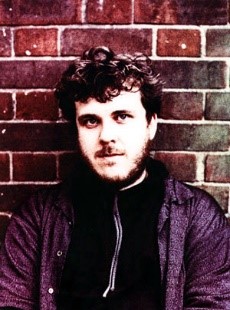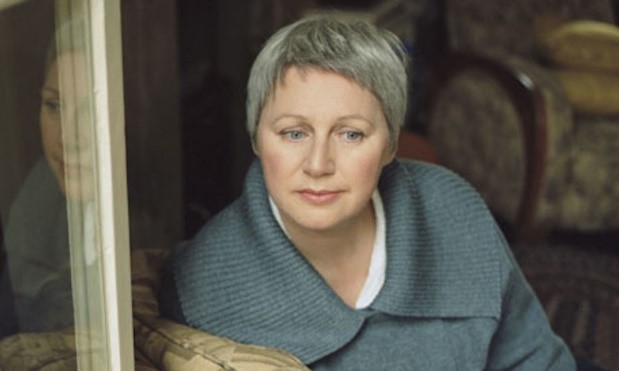Pearly Dewdrops' Drops: A Cocteau Twins Retrospective
As you read, listen to the playlist by clicking on the streaming service of your choice. Note that Spotify does not have some of the later songs in the playlist due to being unavailable.
Perhaps you should save this playlist for a relaxing morning or a moment you’d like to get away from the day-to-day and meditate or just chill with some friends. The music of Cocteau Twins is perfect for that and has the tendency to render you relaxed and blissful after a good listen. They are a favourite artist of mine whose music brings a smile to my face every time I hear it.
Guthrie, Fraser, & Heggie circa 1982
Very few artists have achieved as distinctive and singular a sound as Cocteau Twins. A song by them can be identified within a few seconds. And while many have emulated them no one has captured their sound with the beauty and richness of the original. In making this playlist there is a competing tension to include all the songs since their music is so consistently good and enrapturing, while also realizing that same consistency suggests fewer songs can provide a sufficient representation. Of course, there was a progression and development of their sound over the years, but unlike many other artists I have profiled, you can compare the Cocteau Twins’ last song to their first and find remarkable similarity. What is undeniable is they are a band that did their own thing and stood separate from other artists of their era, and as a result are tremendously respected and revered despite never being able to capture a broad following.
Shallow Then Halo \ Garlands (1982)
The Playlist
Shallow Then Halo
Feathers-Oars-Blades
Peppermint Pig
Song to the Siren
In Our Angelhood
Because of Whirl-Jack
The Spangle-Maker
Pearly Dewdrops’ Drop
Ivo
Pandora
Aikea-Guinea
Kookaburra
Pink Orange Red
Plain Tiger
Great Spangled Fritillary
Little Spacey
Love's Easy Tears
Sea, Swallow Me
Crushed
Blue Bell Knoll
Athol-brose
Iceblink Luck
Fotzepolitic
Road, River and Rail
Be Still (Remix) (not on Spotify)
Evangeline
Summerhead
Tishbite
Teardrop
Monument
Moses
I Heard the Owl Call My Name
Formed in 1979 in Grangemouth, Scotland, a community just a 45-minute drive west of Edinburgh and on the shores of the start of the Firth of Forth, Cocteau Twins were brought together by guitarist Robin Guthrie and bassist Will Heggie, who quickly enrolled fellow clubgoer Elizabeth Fraser on vocals. The band would take their name from a song by a Scottish band that would go on to become Simple Minds (who would rename that song “No Cure” for their debut album in 1979).
Influenced by the darker, post-punk sounds of bands like Siouxsie and the Banshees, Cocteau Twins developed a similar bass and drums sound highlighted by Fraser’s distinctive vocals. They were signed by the new indie label, 4AD, in 1982 and released their first album, Garlands, in September of that year. The album is a full work with no particular song standing out, yet all demand to be heard. Helped, as were so many, by BBC DJ, John Peel, the album managed to get to #5 on the UK Indie Chart and establish a small following for the band.
In “Shallow Then Halo” you can already hear many of the signature sounds of the band, with Guthrie’s echoey, layered guitars and Fraser’s vocals, perfectly matched and floating over the music. However, they are easily grouped with other dark-pop bands of the era and could even be considered a Goth band based on this release, though lacking the macabre imagery of that genre Cocteau Twins wouldn’t bring that conclusion immediately to mind.
Feathers-Oars-Blades \ Lullabies EP (1982)
Peppermint Pig \ Peppermint Pig EP (1983)
As often the case with new bands, especially those that have been together a few years before their first release, there was an abundance of pent-up music to be issued. The Lullabies EP was released just a month after the first album and featured four new songs, including “Feathers-Oars-Blades” which reveals the band in a slightly punkier, aggressive sound. “Peppermint Pig” was first released as a 7” single and then as an EP with the inclusion of a third song. Issued in April the following year it continues with the band’s dark-pop sound but has a less moody, more accessible feel. It is the only music produced by someone other than themselves, using Alan Rankine from the band, The Associates. It appears the band didn’t care for this influence and criticized the results.
Song to the Siren \ It’ll End in Tears by This Mortal Coil (1983)
4AD, founded by Ivo Watts-Russell, would quickly become an important indie label, launching many distinctive and influential bands over the 80s and 90s. Indies in the UK were prone to issuing mini-compilations of their artists, which led to many fantastic albums for collectors that bring rare singles, early versions of songs, and wonderful assortments of artists together on a single release. Watts-Russell would do something slightly different and intriguing with 4AD, and that was to put out collaborations by his artists. Most of this work would be released under the band name, This Mortal Coil, which would produce three fantastic albums over the next ten years. Each song, almost always a cover, would feature different singers and be performed by different combinations of 4AD artists, with Ivo curating the project.
Fraser, from the "Song to the SIren" video
The impetus of this approach was a project to record some Modern English material the band themselves didn’t want to record under their name, so Ivo enlisted 4AD artists to record it under the pseudonym, This Mortal Coil. Originally planned as the B-side, Guthrie and Fraser recorded a cover of folk singer Tim Buckley’s song, “Song to the Siren.” The result was so strong that Ivo switched it to the A-side and Cocteau Twins ended up with their first minor hit, though not in their name. The single’s success led Watts-Russell to expand the initiative and compile the album, It’ll End in Tears, a year later. “Song to the Siren” would only reach #66 on the UK Indie Chart but would be on the chart for 101 weeks, the fourth longest run in the 80s following similarly sounding artists Bauhaus (“Bela Lugosi’s Dead”), New Order (“Blue Monday”) and Joy Division (“Love Will Tear Us Apart”). The song also had the effect of reinvigorating interest in Buckley’s work, leading to a posthumous rise in his sales as well as interest in the music of his son, Jeff.
The release of this song marked a few notable changes. It was the first recorded without Will Heggie, who amicably split with the band after their promo tour for “Peppermint Pig.” Perhaps this is a reason “Song to the Siren” features no bass and relies almost solely on Fraser’s exquisite vocal. It also has an increased reliance on keyboards, with only minor guitar work from Guthrie, marking a new approach for their sound. It also has discernable words in the vocals. As is obvious listening to this playlist, Elizabeth uses her voice more as an instrument than a traditional lead vocal, and it is rare in which the lyrics are discernable or even if proper words are being used. She has always been vague about whether there are proper lyrics for many of the songs though has noted she may use foreign words without knowing their meaning. Given this song is a cover, she remains fairly true to the original composition.
In Our Angelhood \ Head Over Heels (1983)
The band’s next album, Head Over Heels (a popular title among 80’s artists) would come out on Halloween later that year. Like the first album it is a complete work that features no obvious singles and demands to be listened as a whole. Not surprisingly, the change in sound without Heggie’s sonorous basslines led to a brightening of their sound, though not entirely out of the dark, moody soundscapes of their prior work. Still more rhythmic than melodic, there was yet a slightly more accessible sound to the music. Critically acclaimed, it would reach #1 on the UK Indie Chart and even #51 on the UK Chart. The Twins would yet to receive any attention outside the UK at this point.
Because of Whirl-Jack \ Sunburst and Snowblind EP (1983)
The Spangle-Maker; Pearly Dewdrops’ Drop \ The Spangle-Maker EP (1984)
A trend was developing, reminiscent of Joy Division\New Order and many other indie artists of the era, of Cocteau Twins releasing their brighter, more accessible songs on singles and EPs while making their albums more thematic and moody, allowing for deeper explorations of their sound. This makes sense because the singles and sounds on the EPs wouldn’t fit cleanly on the albums and would be a distraction. So I suspect when Guthrie and Fraser wrote a song that stood apart, it would be left for a single or EP. Of course, ‘stood apart’ is all relative since they were all unmistakably Cocteau Twins’ songs.
Fraser, Raymonde, & Guthrie circa '84-'85
Two EPs were released in late ’83 and early ’84. Sunburst and Snowblind would include a song, “Sugar Hiccup,” that was also on the Head Over Heels album but otherwise offer three new songs such as “Because of Whirl-Jack.” It includes piano, brighter guitar, a greater range in vocals, and a faster pace than most of the band’s other work at the time and is a nice signal of their evolving sound.
The Spangle-Maker is an important release in the band’s sonic evolution. First, it was the initial recording to include new band member Simon Raymonde, a multi-instrumentalist that Guthrie and Fraser met during the recording for This Mortal Coil. The single “Pearly Dewdrops’ Drop” and the EP would both go to #1 on the UK Indie Chart, signalling Cocteau Twins were establishing themselves as a leading act of the alternative UK music scene. The Spangle-Maker is a little catchier and Guthrie’s guitar work starts to take on the ethereal textures that would be the hallmark of their sound thereafter. Raymonde’s bass also adds new depth and melody. Cocteau Twins would be considered pioneers of what would be referred to as ‘Dream Pop,’ and this EP starts to establish that sound. The title track on the EP even has some proper lyrics.
Ivo; Pandora \ Treasure (1984)
As noted with the prior EP that year, the new album would break new ground for the band. “Ivo,” a tribute to their label’s founder, is the first expression of the band’s guitar-driven, expansive sound and Fraser’s full embracing of her vocal as a luminescent and transcendent element in the Twins’ sound. This is an unabashed pop song, though unlike anything to be heard on the charts during this time. Of course, this wouldn’t reach the charts as the album featured no singles. “Pandora” is also a fantastic example from the album, showing almost an R&B feel to the band’s dreamy sound. Treasure reached #2 on the UK Indie Charts, not equalling the prior album’s peak, and gained some attention in Australia and New Zealand, but over time has been elevated by fans to be one of the most beloved of their discography.
These were the two songs that brought Cocteau Twins to my attention. I had heard of them and probably heard “Song to the Siren” but didn’t know it was them. I would pick-up Aikea-Guinea soon after and the 7” single for “Pearly Dewdrops’ Drop” a bit later, but I initially found them via a compilation album from Vertigo records called The Vertigo Sampler. I’m not sure of the relationship between Cocteau Twins and Vertigo, I suppose it was a distribution deal for either Europe or North America, but this album includes both these songs from Treasure and many good songs from the likes of The Boomtown Rats, Tears for Fears, Big Country, The Icicle Works (I think I bought the album to get “Whisper to A Scream”), Love and Rockets, The Cult, Gene Loves Jezebel, and Colourbox. This was an important album in the growth of my musical tastes at the age of fourteen, and these Cocteau Twins songs were favourite and oft-included songs on my mix tapes over the ensuing years.
Aikea-Guinea; Kookaburra \ Aikea-Guinea EP (1985)
Pink Orange Red; Plain Tiger \ Tiny Dynamine Ep (1985)
Great Spangled Fritillary \ Echoes in a Shallow Bay EP (1985)
1985 wouldn’t see the release of another album, but would still be an important year for the band as they released three EPs that would continue to evolve both their sound and their following. All three releases reached #1 on the UK Indie Chart. Aikea-Guinea with the beautiful title track once again showed how Fraser’s vocals floating over a persistent and low-end rhythm from Guthrie and Raymonde could produce exquisite and uplifting results. “Kookaburra” is a faster-paced tune that employs the same formula but with guitar-splashed accents to give the song intriguing variance. These songs are increasing in complexity and ethereal beauty as Elizabeth continues to find ways for her voice to elevate the songs.
Tiny Dynamine continued the band’s exploration of brighter sounds, subdued pace, and a more approachable sound. “Pink Orange Red” employs guitar that would be de rigueur with Shoegazers a few years later, while “Plain Tiger” is a wonderful song that does however, bring more distinct interaction between guitar, bass, drum, and vocal than the usual wall-of-sound that was becoming their formula.
Echoes in a Shallow Bay doesn’t break new ground but of course includes a few more gems to sit back and be enveloped by, such as “Great Spangled Fritillary” which sees Guthrie layering different guitar sounds into wonderful interplay, again providing the groundwork for the fuzz-laden guitar genres coming soon.
Little Spacey \ Victorialand (1986)
The band’s fourth album would be from Guthrie and Fraser as Raymonde focused on the next album for This Mortal Coil. The result is a largely acoustic album with less vocals and no drums, allowing Guthrie to fuller explore his evolving soundscapes with the guitar. It is rightly labelled an ‘ambient’ album more so than their others, and in this regard sets it slightly apart in their canon. “Little Spacey” is one of the more vocalized tracks on the album but indicative of its lighter, brighter sound. Oddly, given the less accessible style of the album, it would go to #1 on the UK Indie Chart and crack the top ten in the UK Chart, most likely a result of the built-up success of the three preceding EPs.
Love’s Easy Tears \ Love’s Easy Tears EP (1986)
Sea, Swallow Me \ The Moon and the Melodies with Harold Budd (1986)
Crushed \ Lonely Is an Eyesore – Various Artists compilation (1987)
Not surprisingly the next issuance was an EP, coming out five months after Victorialand and continuing the development of the band’s signature sound. “Love’s Easy Tears” has a stronger and more passionate sound than usual, and there is a beautiful combination of guitar and bass that rumbles throughout, a sound that would come to brilliant fruition over the next two Cocteau albums.
Love’s Easy Tears was released just ahead of an album written and recorded with composer Harold Budd and not released under Cocteau Twins’ name (it was credited individually to Budd, Guthrie, Fraser, and Raymonde). “Sea, Swallow Me” is a slightly more accessible and straightforward song than the instrumental and more ambient songs from the rest of the album, The Moon and the Melodies. The EP and this album continued the band’s streak of #1 releases achieved on the UK Indie Chart, unbroken since Aikea-Guinea.
The following year, 1987, would be a quieter year, with just one song put out on a 4AD artists compilation, Lonely Is an Eyesore. This is an album I also picked up a few years later and discovered many great new and missed artists from 4AD’s first six years of output. “Crushed” surprises with something that sounds almost like a hit single, with catchy melodic passages and upbeat sounding lyrics. Of course, it was not released as a single and I think the band missed a chance to gain a farther-reaching hit.
Blue Bell Knoll; Athol-brose \ Blue Bell Knoll (1988)
While enjoying strong underground success within the UK with 4AD, the Twins still lacked broader exposure and the opportunity to enjoy greater success. 4AD had signed a distribution deal with Relativity Records in 1985 which got Cocteau albums and singles into international markets, but they remained an obscure and largely unrecognized act outside the UK (despite the release of a compilation, The Pink Opaque, to catch up North American audiences with the pre-’85 music). This changed in 1988 when they signed with Capitol Records in the US. Blue Bell Knoll, their fifth full album, would be the first under this major-label contract.
The album itself was a blend of the ambient and dreamy music of Treasure infused with the more progressive and aggressive guitar-work of the recent EPs. The pure ambience of Victorialand and Moon and the Melodies was largely set aside for stronger, more traditionally structured pop songs. The lead song, the title track, was a marked departure in sound with a strong synth-led melody and de-emphasis on guitar aside from a crashing, fuzzed-out crescendo finish. It was the kind of song to gain some attention for new audiences. The rest of the album is also strong, including the single released in the US, “Carolyn’s Fingers,” and the lovely “Athol-brose” (recently reinvigorated by the cover by Nouvelle Vague, who brings their characteristic Bossa Nova/Lounge sound to it).
Once again going to #1 on the UK Indie Chart, the album reached #15 on the UK Chart, their second-best result after Victorialand. However, it also appeared on the US Chart, reaching #109, indicating American audiences were getting exposure to the Cocteau sound most likely and mainly through College Radio. In Toronto local radio station CFNY had been playing them for years, as other prominent alternative stations across North America likely were too, but these would reach too small an audience to gain the band prominent exposure. Blue Bell Knoll would place #27 on CFNY’s year-end list in 1988 (in 1985, Treasure and Aikea-Guinea were packaged together in Canada and reached #39 on CFNY’s year-end chart that year). It would seem Cocteau Twins were establishing a position for an international breakthrough.
Guthrie, Fraser, & Raymonde
Iceblink Luck; Fotzepolitic; Road, River and Rail \ Heaven or Las Vegas (1990)
1989 would be the first year the band released no music since their debut in 1982, but they more than made up for it with the release of their sixth album in 1990, Heaven or Las Vegas. I can safely say this ranks in my top ten favourite albums. It was the perfection of the Cocteau Twins’ sound, with deep, rich blends of guitar and bass, more melody than had been heard before, and Fraser’s vocals riding once again effervescently over the music (including some discernable lyrics - I recall reading an article/interview with the band regarding this album, and experiencing their first success in Japan, where lyrics must be printed in the packaging by law. Fraser refused to provide written lyrics so the label had someone try to discern them and that is what was going to be printed. When Fraser saw the proposed lyrics on the packaging and how ridiculous they were, including lines like “I will hit you with my aeroplane,” she agreed to provide lyrics for the packaging. This suggests truly she didn’t write lyrics for songs, but rather had a vocalization in mind to accompany the music.). The new album included the bright, layered guitar from Tiny Dynamine, Fraser’s continued refinement of her vocal instrumentation now brilliantly blended and mixed with the music, the ethereal and ambient textures of Treasure without getting lost in the pure ambience of Victorialand, and the accessibility and traditional song structures of Blue Bell Knoll.
Being released on a major label would end the band’s run of #1 placements on the UK Indie Chart, but would reach #7 on the UK Chart, their highest rank of their career. The album would barely crack the top 100 in the US, yet generally this would be their most highly regarded and widely heard album, bringing them larger audiences on tour. I saw them at Massey Hall in November of 1990, a decent venue for a band of their stature. I decided late to go on my own when I couldn’t find anyone else interested (people really didn’t know who they were), so I bought a single ticket and scored a good seat. The show was beautiful, with cascades of colour basking the band as they played, which featured one bass player, four guitarists, and Fraser – no drummer of course, the band would not have one until their last albums. To this day I am so glad I got to hear the songs of Heaven or Las Vegas live.
There is not a bad song on this album. The title track is strong (and would be the second single released in the US), but the deep tracks like “Fotzepolitic” and “Road, River and Rail” have an R&B richness that infused their music with new depth and an emotional pull that their prior music lacked. The walls of guitar were less impenetrable, and the band seemed more approachable. There was much greater use of electronics, as heard in songs like “Cherry-Coloured Funk” and “Pitch the Baby.” The album is a masterpiece.
Fraser in the "Iceblink Luck" video
And then there is “Iceblink Luck,” which other than the US release of “Carolyn’s Fingers” as a single from Blue Bell Knoll, would be the band’s first proper single release from one of their albums (how things change when on a major, huh?). I knew this album was going to be brilliant the first moments I heard this song. It sprung from the radio like a burst of sunshine, standing out from everything else, and that was saying something in an incredible year of music. I bought the cd and rushed to my girlfriend’s house to play this song and to share this incredible, creative new music. Her father, a scholar of classical music and listening from the next room, called out his opinion after I played it on their stereo, “typical.” I was pissed off for the rest of the day, ranting how I was going to call Bach and Beethoven “typical” next time he played them. I tell ya, this song grabbed me unlike many over the course of my lifetime. Admittedly it’s hard to hold that kind of passion for a song over the years, especially after listening to it a few hundred times, but for Cocteau Twins it was the most pop-sounding they’d ever been, without compromising their unique sound and vision. “Iceblink Luck” would reach #22 on CFNY’s year-end singles chart.
Be Still (remix) \ Peace Together by various artists (1993)
Peace Together was a fundraising effort to promote peace in Northern Ireland. Various artists provided cover songs to the album, but a group including Peter Gabriel, Sinead O’Connor, Feargal Sharkey, Jah Wabble, and Hothouse Flowers recorded an original called “Be Still.” At the end of the album is a remix of that song by Robin Guthrie with the vocals done entirely by Elizabeth (some of Sinead’s original backing vocal is maintained). This makes this, more or less, a Cocteau Twins effort even if they didn’t write the song. It’s a great version of the song and it’s a nice change to hear Fraser sing straight-up lyrics.
Evangeline; Summerhead \ Four-Calendar Café (1993)
As they released their most successful and celebrated album the band was also facing its first signs of adversity. Conflicts with Ivo Watts-Russell would lead to them severing ties with 4AD, signing with Fontana instead, a sub of Mercury Records, while maintaining their Capitol contract in America. Robin was also dealing with addiction issues (proving even artsy bands have rock n’ roll issues), leading almost to the break up of the band. Guthrie and Fraser had been in a relationship for years and had a daughter in 1989. They would work together through his rehab and she underwent psychotherapy. Their music was put on hold while their personal lives were brought back to order.
Thus, after the longest break of their career they returned with their seventh album, Four-Calendar Café, which was good but couldn’t replicate the grace, depth and energy of Heaven or Las Vegas. The momentum had been lost, and it seemed they were trying now to appeal to a broader audience – major label influence, perhaps? – and hold to more traditional song structures. Their signature sound was still there, but the creativity and excitement of their brand seemed to be weakened. “Evangeline” was a decent song and reminiscent, honestly, of the songs from the prior album, yet too pleasant, too much the same, too… safe? The album definitely has some good moments, and “Summerhead” is reminiscent of the energy and iconic soundscapes of their Aikea-Guinea era.
Of course, despite being a less creative work the album would do comparably well. UK audiences, more experienced with Cocteau Twins’ music, only brought the album to #13 (Heaven or Las Vegas had reached #7), while American audiences were just catching on and this more accessible version of the band would reach a career high #78 on the US Chart.
Tishbite \ Milk and Kisses (1996)
“Bluebeard” was released as a second single from Four-Calendar Café in 1994 and the band would release three more EPs: Snow in 1994 which was a couple of traditional Christmas songs, and Twinlights and Otherness, which were released together in 1995 as precursors to the next album and were an instrumental and a remix, respectively.
Milk and Kisses, the band’s eighth album, was released in March of 1996 and while it did ok – again charting in the top 20 in the UK and reaching #99 in the US – it was becoming evident Cocteau Twins no longer had the spark. Ironically, as bands influenced by them, such as Portishead, were enjoying success, the Twins would be winding down. Like Four-Calendar Café the album had all their signature sounds yet lacked the freshness and depth of when they originally explored them. “Violaine” was the second single and it lacks neither the hypnotic rhythm or lush melodies we’d come to expect. Similarly, most of the album dabbles in electronics, guitar, or vocals without ever utilizing any to full effect. Fraser does seem to experiment more with her vocals, utilizing backing vocals that are almost Motown inspired, yet this too seems to distance the songs from their sound and not in a helpful way. It’s the kind of album you forget you’re listening to until it suddenly stops and leaves you in silence.
One exception was the lead single, “Tishbite,” which surprisingly grabs an R&B vibe and explores it with a more straight-ahead treatment rather than trying to blend it with the wash of the Cocteau sound. The result is a great effect, especially Fraser’s soulful vocals over the outro, displaying a style never heard from her before. If they had been able to achieve this throughout the album (though “Rilkean Heart” is pretty good too) it could have signalled a new stage in their career.
The band returned to the studio to record their next album in 1997. Alas, Guthrie and Fraser’s decision to break-up their personal relationship led to the band abandoning the new project, leaving Milk and Kisses as their final release.
Teardrop \ Mezzanine by Massive Attack (1998)
Monument \ Continental by Robin Guthrie (2006)
Moses \ by Elizabeth Fraser (2009)
I Heard the Owl Call My Name \ Moon by Snowbird (2014)
Cocteau Twins would never again reform, with an abandoned plan for a reunion for the 2005 version of the Coachella Festival as well as ensuing tour dates as the closest they would come. Fraser was the one to apparently call it off.
Output from the trio since has been varied, with activity not picking up until many years after their breakup. Elizabeth Fraser would become romantically involved with Damon Reece, drummer with bands Spiritualized, Echo & the Bunnymen, and Lupine Howl, and had a daughter with him in 2008. She appeared to settle into a more domestic lifestyle, limiting her musical career to only guest spots on others’ efforts (something she had already been doing throughout her career – the appeal of which for others is understandable given how distinctive and interesting her voice can make a song). Perhaps one of her most famous guest appearances was on Massive Attack’s celebrated album, Mezzanine, including a performance on its most iconic song, “Teardrop.” Perhaps it’s not a surprise this song stands out among the band’s repertoire given the character her voice lends to their sound. Fraser would also surprise many by releasing a solo song in 2009. “Moses” was recorded with Reece and Jake Drake-Brockman (of Echo & the Bunnymen) and then issued as a tribute after Drake-Brockman died in a motorcycle accident that year. She would also perform live shows at a festival in 2012 featuring new material, with hints of an album to come that has yet to materialize. Given the strength of “Moses” I would very much like to hear more from her. She has done some film and TV work, including the Lord of the Rings soundtracks and scores done with Reece to accompany a drama series, The Nightmare Worlds of HG Wells (2016), but admits to being afraid to perform again.
Guthrie and Raymonde formed a label, Bella Union, and in 2003 Guthrie started releasing solo albums and has now released six in total along with several EPs. He also recorded EPs and albums in the early 2000’s with Siobhan de Maré in an act called Violet Indiana and has guested as a producer and performer on a host of others’ music over the years. “Monument” is a song from his second solo album, Continental, and shows how his instrumentals are just Cocteau songs waiting for Elizabeth’s vocal to complete the package.
Raymonde, aside from running Bella Union, has done production work for a variety of artists, some radio work on BBC, and most recently formed a band with Stephanie Dosen, ex-guest singer for the likes of Massive Attack and Chemical Brothers. They perform under the name Snowbird and released an album, Moon, in 2014. Not sure of the influences but the songs seem to be nature inspired with many references to woods, trees, birds, owls, bears, foxes, and mice (not to mention the band’s name itself). The album is an electro-acoustic sound and generally down tempo, but it’s curious that there’s an Elizabeth Fraser-like quality to Dosen’s vocals.
Cocteau Twins were a wondrous and unique presence in the new wave, dream pop, and ambient music scenes of the 1980s and 90s. The creative power of Guthrie’s lush guitar work and Fraser’s expansive and creative vocals made for their own sound that inspired many bands to copy, but never equal, their sound. The aforementioned Portishead comes to mind, as well as Canadian act, Rose Chronicles, from the early 90s. Listening to the guitar work on songs such as “Pink Orange Red” you can easily hear the genesis of what was to come from bands like Slowdive, Curve, Lush (who would have an EP produced by Guthrie), Spiritualized, and The Cranes during the shoegazing wave in the early 1990s. I feel the Cocteau Twins have been largely lost in the annals of music, despite a massive box set release in 2005 (with so many of those coming out now, who can keep track). But their brilliance and wonderful music deserves to be remembered and celebrated for the influential and uplifting contribution that it was.








































